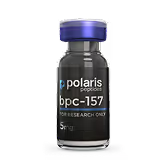Retatrutide
Retatrutide is a designer peptide that activates three key metabolic receptors to tackle both blood sugar and weight in one treatment. When given once weekly by injection, it reduces appetite, enhances insulin release, and boosts calorie burning. Early human trials show significant weight loss and improved blood-sugar control, making it a promising option for managing obesity and type 2 diabetes.
Compound Overview
About the product
The molecule is based on native GIP and GLP-1 sequences with modifications—including fatty-acid acylation—for albumin binding and prolonged circulation. It includes amino-acid substitutions to balance receptor affinity across GIP, GLP-1, and glucagon receptors. No non-natural amino acids are used beyond these targeted changes and the lipid linker. Retatrutide is synthesized by solid-phase peptide synthesis and purified by preparative chromatography to research-grade purity, with mass spectrometry confirming its structure.
Retatrutide binds to GIP and GLP-1 receptors in the pancreas and brain to stimulate insulin release, reduce appetite, and slow gastric emptying. Simultaneously, it engages glucagon receptors in liver and fat tissue to boost energy expenditure and fat breakdown. This triple-receptor activation promotes weight loss through both decreased food intake and increased calorie burning, while improving glycemic control via enhanced insulin action and reduced hepatic glucose output.
The peptide is studied for its combined effects on weight reduction and metabolic health. In early clinical trials, retatrutide produced substantial body-weight loss and improvements in blood-sugar markers compared with placebo. Participants also reported reduced appetite and improved measures of cardiometabolic risk. It is being evaluated as a potential therapy for obesity and type 2 diabetes, with ongoing studies assessing longer-term efficacy and safety.
Retatrutide side effects commonly include nausea, vomiting, and transient diarrhea, consistent with other incretin-based therapies. Injection-site reactions and occasional headache have also been reported. Most gastrointestinal symptoms diminish over several weeks of treatment. No serious safety signals have emerged in trials up to six months, but longer-term data are pending. Monitoring of liver function and vital signs is recommended in trial protocols.
Retatrutide is assembled via solid-phase peptide synthesis, incorporating the three receptor-targeting sequences and a fatty-acid linker for half-life extension. After cleavage from the resin, it is purified by preparative HPLC to over 95 percent purity. Analytical HPLC and mass spectrometry verify peptide identity, purity, and correct lipid conjugation. Manufacturing follows peptide-compounding standards under good laboratory practice.
Retatrutide is classified for investigational use only and has not been approved by the U.S. FDA, EMA, or other major regulatory agencies. It is available exclusively through clinical-trial programs and cannot be prescribed outside those settings. No commercial or over-the-counter formulations exist. Use is restricted to protocols approved by ethics and regulatory review boards.
Retatrutide dosage in human studies has typically involved once-weekly subcutaneous injections ranging from 1 mg to 12 mg, with gradual dose escalation to enhance tolerability. Most weight-loss trials use target doses of 5–10 mg weekly over 24–48 weeks. No dosing guidelines exist outside trial protocols. All dosing should adhere to approved clinical-trial designs.
- Do follow trial-specific titration schedules to minimize gastrointestinal effects.
- Do monitor weight, glycemic markers, and liver enzymes regularly.
- Don’t combine with other incretin or glucagon-based therapies off-protocol.
- Don’t use outside ethically approved research frameworks.
- Q: How quickly does weight loss occur?
- A: Significant reductions are often seen within 12–16 weeks of weekly dosing.
- Q: Can retatrutide be used in type 2 diabetes?
- A: Early trials show improved HbA1c levels in participants with diabetes.
- Q: Is daily dosing possible?
- A: Only once-weekly administration has been studied to date.
For research use only. Not approved for medical use.


